To those new to property development, it may all seem quite uninspiring. Sure, they can appreciate that it’s profitable, but they’re bored to tears by buildings and construction.
Not me.
I enjoy being involved in the building process, excited by construction, and more than anything, I’m an avid fan of beautiful architecture. I’ve travelled much of the world, to large and small cities, and am captivated by the diversity and beauty of different buildings and their styles. The way they interact and adds to their surroundings, the way they shape the feel of a vicinity, and the way they influence how people interact with them.
In Australia, my favourite city in which to indulge my love for architecture is Melbourne. It’s hard to pick a favourite, and the best way I know how to explain why I’ve come to this conclusion is to share my favourite John Sage Melbourne buildings.
Shrine of Remembrance
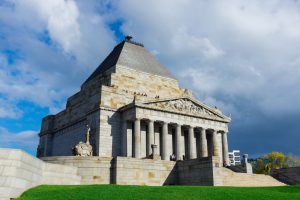
From as far back as I can recall visiting Melbourne, the Shrine of Remembrance has been on my itinerary of must-see buildings. It’s so much more than a building, however. It has been opened since 1934 to honour the service and sacrifice of Australian men and women in war and peacekeeping. It was renovated in 2014, and it is both a shrine and a building. It’s a wonderful mix of architectural ideas, meshing references to Egypt’s pyramids and the Mausoleum at Halicarnassus in Turkey. I enjoy looking at the surrounding Shrine Reserve from the balcony of the Shrine – it’s a perfect place for reflection.
St Paul’s Cathedral
Designed by distinguished English revival architect William Butterfield, the Cathedral is built in the neo-Gothic transitional style. The plan of St Paul’s is a traditional Latin cross, with a long nave, side aisles, short transepts, a tower at the crossing, with choir below, sanctuary and altar beyond, and a pair of towers framing the ceremonial main entrance.
The interior stonework is a mixture of sandstone from the Barrabool Hills and Waurn Ponds limestone, with contrasting stripes of Victorian bluestone, which gives the cathedral a warm colouring. Because the spires are built from Sydney sandstone and are 40 years newer, they are a different, darker colour than the older parts of the building. Maybe it’s finding a refuge from the bustle of the city, but I enjoy visiting the Cathedral and always feel a great sense of calm within.
State Library of Victoria
A well-stocked library was always going to be in my good books (pun intended), but the design of this one makes it particularly special. Give me an afternoon in the Domed Reading Room in one of those rickety wooden chairs and I’m a happy man.
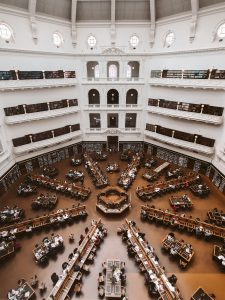
Old Treasury Building
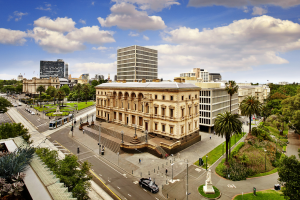
What were you doing at 19? In 1857, a 19-year-old architect, John James ‘JJ’ Clark was creating the first drawings for one of Melbourne’s finest 19th century buildings – the Old Treasury Building. His design is in the Renaissance Revival style, derived from the ‘Italian palazzo’ form popular in the nineteenth century.
The exterior was constructed with Bacchus March sandstone (or freestone) from the Bald Hills quarry, approximately 50 kilometres west of Melbourne. The bluestone foundations were mined from Footscray, and the floor above the barrel-vaulted basement is one metre thick. I always think it gives buildings a sense of place when they’re constructed from local materials.
Royal Exhibition Building
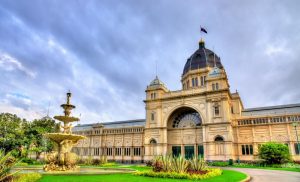
Did you know that the Royal Exhibition Building was the first building in the country to be awarded UNESCO World Heritage status? Completed in 1880, it was built to host the first official World’s Fair in the Southern Hemisphere. Though smaller sections have been lost to fire or other damage, the Great Hall has survived. Few things say ‘Melbourne’ to me as much as seeing the great dome!
Curtin House
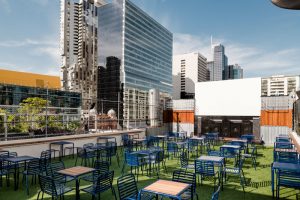
Similar to the Old Treasury Building, Curtin House is based on the Commercial Palazzo style, and adorns Melbourne’s city centre on Swanston Street. In recent years it’s become known as a ‘vertical lane’, and I enjoy this modern interaction with this beautiful building. Its six storeys are occupied with a range of specialist retailing, dining, and entertainment spaces. The rooftop cinema is particularly charming.
RMIT University Building 8

Suitably housing RMIT’s School of Architecture and Design, this Swanston Street landmark adds a more modern design to my list. It’s a colourful, eclectic mix of brightly coloured stone and mosaics with protruding gold-framed windows whose shapes reference the gothic style of RMIT’s older city campus buildings. I think it’s a brave and vibrant addition to the other wonderful buildings in Melbourne’s heart.
Flinders Street Station – Melbourne
How could I do this list and not mention the iconic Flinders Street Station? Reminiscent of a French Renaissance style, showcasing a large dome over its main entrance and that famous clock tower, it has been gracing the city’s heart since the early 1900’s. No visit to Melbourne is complete without a trip to Flinders Street Station.

Manchester Unity Building
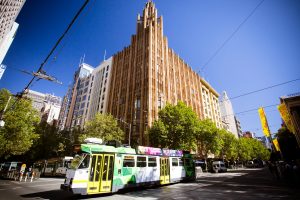
Being next to the Melbourne Town Hall, the stunning art deco architecture of the Manchester Unity Building often gets overlooked. The design features buff-coloured cladding, vertical ribbing, and a Gothic crown that includes numerous flying buttresses.
The Forum
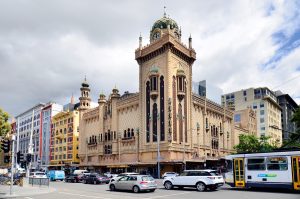
Though these days I don’t know many of the artists who perform here, The Forum is still a gorgeous Melbourne building. It was built in 1929 as an ‘atmospheric theatre’, a design which introduced an exotic European setting when it was common to have boring, boxy theatres. The inside features several Greco-Roman statues, ornate balconies, and gargoyle-adorned alcoves. The exterior is done in a Moorish Revival style, complete with tall spire-like minarets and a clock tower.
John Sage Loves Melbourne Architecture!
It is a thoroughly rewarding and enjoyable experience to look up and admire the grand, elegant architecture of Melbourne’s heritage buildings and their bold, striking contemporary neighbours. The decisions that are made about buildings and architecture have a special significance – it’s what our lived environment will look like for years to come. I can only feel gratitude towards those who designed, approved, and constructed these and many other buildings which make Melbourne an amazing place to appreciate architecture.